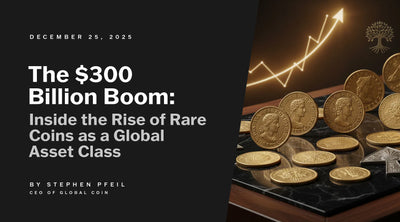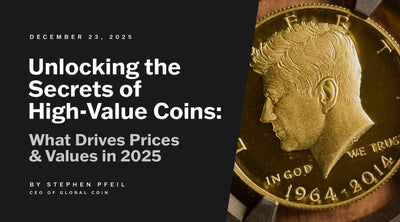Central Bank Gold Buying Trends: Record Surge Boosts Global Prices
Why are central banks buying gold in record amounts? Economic uncertainty, inflation, and geopolitical tensions are driving central banks to increase their gold reserves. Many central banks are implementing multi-year strategies to increase gold holdings as part of long-term reserve...

Why are central banks buying gold in record amounts? Economic uncertainty, inflation, and geopolitical tensions are driving central banks to increase their gold reserves. Many central banks are implementing multi-year strategies to increase gold holdings as part of long-term reserve diversification. Gold acts as a safe haven, protecting against financial volatility, with gold's performance as a stabilizing asset during financial crises and systemic changes. This article examines the factors behind central banks’ gold buying and its impact on global markets.
-
Central banks are projected to increase gold purchases by at least 20% in 2025, driven by economic instability and inflation concerns, reinforcing gold’s role as a vital asset.
-
Geopolitical tensions and the decline of the U.S. dollar have prompted nations, particularly emerging markets, to accumulate gold as a safeguard against financial volatility and enhance national security.
-
A significant portion of central bank gold purchases remains unreported, indicating hidden demand that influences market dynamics and contributes to rising global gold prices.
-
Central banks often purchase gold through international markets to access credible supply channels and ensure traceability.
Introduction to Central Bank Gold Buying
Central bank gold buying has emerged as a defining force in the global gold market, with central banks worldwide steadily increasing their gold reserves year after year. According to the World Gold Council, central banks have acquired nearly one out of every eight ounces of gold produced globally over the past five years—a testament to the scale and influence of central bank gold purchases on the international stage.
This surge in gold buying is particularly pronounced among emerging market central banks. These institutions are actively seeking to diversify their foreign exchange reserves, reducing their reliance on the US dollar and other traditional reserve assets. By increasing their official gold reserves, central banks aim to strengthen their financial security and enhance the resilience of their economies against external shocks.
The momentum behind central bank gold buying shows no signs of slowing. Recent surveys indicate that 95% of central bankers expect official gold reserves to rise over the next 12 months, reflecting a strong consensus on gold’s enduring value as a strategic asset. As central banks worldwide continue to prioritize gold accumulation, their actions are reshaping the dynamics of the global gold market and reinforcing gold’s role as a cornerstone of reserve management.
Central Bank Gold Purchases in 2025

Analysts predict that 2025 will witness a dramatic increase in central bank gold purchases, with expectations of at least a 20% rise compared to previous years. This surge is driven largely by economic uncertainty and inflation concerns, prompting central banks to seek refuge in the stability that gold offers. The World Gold Council has highlighted this trend, noting that central bank gold demand remains a cornerstone of financial security in unpredictable times.
Renewed interest in gold is not unprecedented. In 2022, central banks recorded their highest ever gold demand, purchasing a total of 1,136 tonnes. This historical context underlines the growing reliance on gold as a hedge against economic instability. Central bank purchases have consistently influenced gold market trends and investor confidence. As we approach 2025, central banks are expected to continue this aggressive buying trend, further solidifying gold’s position as a critical asset in their portfolios.
The implications of this trend are far-reaching. Increased central bank demand for gold not only affects global gold reserves but also has a significant impact on market dynamics and investor strategies. The substantial gold purchases by central banks create ripples across financial markets worldwide, influencing everything from gold prices to investment portfolios. Net purchases by central banks play a key role in driving the overall accumulation of gold reserves.
Azerbaijan has emerged as a significant buyer in 2025, underscoring its strategic role in the global gold market.
Geopolitical Strategy Behind Gold Hoarding
The escalating geopolitical tensions are a critical factor driving central banks to bolster their gold reserves. In an era where economic sanctions and currency wars are becoming more common, gold offers a reliable shield against financial volatility. Western sanctions, particularly those imposed on Russia, have significantly influenced the country's approach to gold reserves by restricting access to international markets and prompting a shift toward gold as a strategic asset. Nations are increasingly viewing gold as a safe haven asset, one that retains its value even when fiat currencies falter.
Gold’s historical significance as a trusted asset continues to play a pivotal role in these strategies. Central banks are not only using gold to hedge against inflation but also to manage risks associated with their currency holdings. Emerging economies’ strategic accumulation of gold is evident as they stockpile to safeguard against financial and geopolitical risks. Fresh tensions in the Middle East have further heightened the importance of gold reserves for countries in the region, such as the UAE and Qatar, as a safeguard against geopolitical shocks.
This strategy is not always transparent. The difference between reported and unreported gold purchases highlights the covert maneuvers of central banks in response to market conditions. Russia's recent gold buying spree, accelerated in response to external pressures and sanctions, exemplifies how nations can rapidly increase their gold holdings during periods of turmoil. Quietly building their reserves allows nations to influence the market without attracting undue attention, highlighting the geopolitical importance of gold hoarding.
Gold Reserves and National Security
Gold reserves play a crucial role in national security, especially in times of economic distress. Central banks are increasingly using gold to diversify their reserves and ensure stability amidst global uncertainties. Many are now raising the proportion of gold within their total reserves as a strategic response to geopolitical and financial risks. Emerging markets find this strategy particularly vital due to the more severe impacts of economic volatility.
The relationship between gold reserves and national security is often underrated but profoundly significant. Holding substantial gold reserves enhances central banks’ ability to respond to economic shocks and maintain confidence in their financial systems. This diversification away from foreign exchange reserves reduces dependence on any single currency or asset, promoting greater economic stability. Within reserves management, gold is recognized as a key component in broader asset allocation strategies, valued for its stability and resistance to sanctions.
Practically, gold serves as a buffer to absorb financial shocks, ensuring nations have the resources needed to navigate crises. This aspect of gold ownership underscores its enduring value in central bank strategies and its critical role in maintaining national security. For central banks, building and maintaining their own gold reserves is a strategic priority to safeguard against future uncertainties.
Impact on Gold Prices

Increased central bank gold purchases have significantly contributed to the rising gold price in global markets. As central banks accumulate gold, the heightened demand creates upward pressure on the gold price, which is especially pronounced during periods of economic uncertainty. This dynamic underscores the critical role of central bank buying practices in driving the gold price higher.
This trend carries significant implications for investors. Rising gold prices may prompt a reassessment of investment portfolios, shifting towards assets that offer stability and protection against inflation. Including gold in investment portfolios can provide diversification benefits, particularly during times of economic instability. Gold investment is often used as a means to diversify holdings and hedge against market volatility.
However, while gold offers protection against inflation, its price can be volatile, presenting potential risks for investors. Central bank buying practices highlight the importance of understanding broader market dynamics and the strategic value of gold as a long-term investment.
Past performance of gold is not indicative of future results. Investors should carefully consider their investment objectives before making any gold investment decisions.
Lessons for Individuals
Individual investors can learn valuable lessons from the gold-buying strategies of central banks. Amidst rising geopolitical tensions and financial uncertainties, gold is perceived as a safe asset. Holding gold allows investors to diversify their portfolios and reduce dependence on any single currency or asset. Gold is just one of several asset classes that can be used to manage risk and enhance portfolio resilience.
There are various instruments available for individual investors to gain exposure to gold, such as exchange traded funds (ETFs), futures, and options. These instruments provide flexibility and accessibility, allowing investors to tailor their strategies to their specific financial goals. Reviewing historical data and conducting thorough analysis can help investors make informed decisions about incorporating gold into their portfolios.
Ultimately, the strategies employed by central banks offer a blueprint for individual investors seeking to navigate the complexities of modern financial markets. Understanding the value of the yellow metal in mitigating risk and enhancing stability helps individuals make more informed investment choices that align with their long-term objectives.
Decline of the U.S. Dollar and Rise of Gold

The decline of the U.S. dollar is a significant factor contributing to the rise of gold. Central banks are increasing their gold reserves to move away from reliance on the U.S. dollar in their financial systems. How much gold are central banks acquiring as part of their reserve strategy? This shift is driven by concerns over the dollar’s declining stability and the desire to reduce vulnerability to USD fluctuations.
BRICS nations, in particular, view gold accumulation as a strategy to challenge the US dollar’s dominance in global trade. This strategic move is part of a broader effort to enhance financial stability and promote economic independence. Gold is increasingly recognized as a Tier 1 asset, equivalent to the safest financial instruments. Notably, gold has now become the second largest global reserve asset, surpassing the euro in central bank holdings.
Emerging markets are at the forefront of this shift, actively increasing their gold reserves to bolster their financial stability. By accumulating gold, these countries are significantly contributing to global reserves and diversifying their portfolios. This trend underscores the growing importance of gold as a critical asset in central bank strategies, reflecting broader changes in the global economic landscape.
Emerging Markets Leading the Charge

Emerging markets, such as China and Russia, are significantly boosting their gold reserves to enhance economic security. China’s central bank, for instance, bought 44 tonnes of gold in 2024, maintaining a large gold reserve of 2,280 tonnes. Similarly, the Reserve Bank of India significantly increased its gold purchases in 2024, totaling 73 tonnes. These large-scale gold acquisitions by emerging markets are part of a deliberate and ongoing effort to reshape their reserve composition and strengthen financial resilience.
In 2024, central banks in emerging markets collectively added 1,045 tonnes to global gold reserves, accounting for the majority of the increase. Central banks are increasingly sourcing gold directly from domestically mined gold, often purchasing gold bars from local producers to support domestic industry and reduce exposure to international market volatility. This trend is expected to continue in 2025, with major economies like China and India leading the surge in gold buying among central banks.
The strategic accumulation of gold by these countries highlights their efforts to bolster economic security and reduce dependence on foreign exchange reserves. These gold acquisitions and sourcing decisions are guided by a reserve strategy focused on diversification and strengthening reserve buffers. This proactive approach mirrors the broader geopolitical and economic shifts shaping the global financial landscape.
Reported Figures vs. Unreported Gold Buying

The discrepancy between reported and unreported gold purchases by central banks is a critical aspect of the current market dynamics. About two-thirds of gold purchases in 2022 were unreported, indicating significant hidden demand in the market. Countries like China and Russia are likely behind these unreported purchases, reflecting their strategic efforts to bolster reserves covertly. Central banks typically acquire gold through the international market, utilizing global exchanges and major currencies to ensure liquidity and efficiency.
The National Bank of Poland has been the largest buyer in recent quarters, significantly contributing to reported gold purchases. The Czech National Bank, for example, has maintained an ongoing gold accumulation program, consistently increasing its reserves and providing transparent reporting. However, the unreported gold buying has driven gold prices to record highs, despite signs that central banks bought at a slowing pace. This hidden demand underscores the complex interplay between market conditions, net buyers, and central bank strategies.
The visible gold demand matched 68.5% of new mine output in the past 12 months, highlighting strong underlying demand amid volatility. Total gold demand is typically broken down into investment, jewelry, and technology sectors, with each category contributing a distinct share to overall demand. This trend reveals the critical role of unreported purchases in shaping market perceptions and influencing gold prices.
Global Coin: Your Safe Haven in an Era of Central Bank Gold Buying
As central banks worldwide amass record amounts of gold to hedge against economic uncertainty, inflation, and geopolitical risks, individual investors must ask themselves—are they following the same strategy? Global Coin provides access to exclusive, high-value gold coins that offer more than just financial security; they deliver tangible ownership of wealth that is independent of fiat currency fluctuations and government policies. Unlike central banks that store gold behind vault doors, Global Coin allows investors to hold history, value, and security in their hands with rare, graded gold and precious metal coins designed for long-term wealth preservation.
Future of Central Bank Reserves
Looking ahead, the future of central bank reserves is poised for further transformation as gold cements its status as a strategic reserve asset. Central banks are increasingly re-evaluating their reserve portfolios, with a growing emphasis on gold’s unique qualities—liquidity, independence from counterparty risk, and its historical role as a store of value. This shift is not only a response to recent economic and geopolitical turbulence but also a proactive strategy to future-proof national financial security.
As the international monetary system evolves, central bank reserve managers are expected to continue diversifying away from traditional assets like the US dollar and government bonds. Gold’s performance as an inflation hedge and its ability to provide stability during market volatility make it an attractive option for central banks seeking to optimize their reserve management strategies. The ongoing accumulation of gold by central banks worldwide is likely to support further growth in global gold reserves, influencing both the global gold supply and market prices.
Moreover, the increasing prominence of gold in central bank reserves may have broader implications for the global financial system. As more central banks buy gold and increase their gold holdings, the yellow metal’s role as a primary reserve currency could be further solidified, potentially reshaping the balance of reserve assets on a global scale. This trend underscores the importance of gold reserve management in navigating the complexities of the modern financial landscape and highlights the enduring appeal of gold as a foundation for long-term financial stability.
Summary
The record surge in central bank gold buying in 2025 is a multifaceted phenomenon with far-reaching implications. Central banks are increasing their gold reserves to hedge against economic uncertainty, geopolitical tensions, and the declining stability of the U.S. dollar. This strategic shift has driven gold prices higher, influencing investment strategies and market dynamics.
Emerging markets are leading the charge, with countries like China and India significantly boosting their gold reserves. The discrepancy between reported and unreported gold purchases highlights the covert strategies employed by central banks to manage market conditions. For individual investors, the gold-buying strategies of central banks offer valuable lessons in diversification and risk management.
As we move forward, understanding the motivations and implications of central bank gold purchases will be crucial for navigating the complexities of the global financial landscape. By aligning investment strategies with these insights, individuals can better protect their portfolios and achieve long-term financial stability.
Frequently Asked Questions
Who is the largest buyer of gold in the world?
The largest buyer of gold in the world in 2023 is China, with purchases totaling 224.88 metric tons. This significant demand underscores China's prominent position in the global gold market.
Are central banks buying gold in 2024?
Yes, central banks are actively buying gold in 2024, with net inflows of gold reserves significantly exceeding the previous average, indicating a renewed interest in increasing their gold holdings.
Why are central banks buying so much gold?
Central banks are buying gold to protect their currency reserves and safeguard national wealth, particularly in anticipation of rising inflation. This strategic accumulation helps them navigate various economic cycles effectively.
Why are central banks increasing their gold purchases in 2025?
Central banks are increasing their gold purchases in 2025 primarily due to economic uncertainty, inflation concerns, and geopolitical tensions, as gold serves as a safe haven asset that offers stability during turbulent times. This trend reflects a strategic response to the evolving global economic landscape.
How do gold reserves contribute to national security?
Gold reserves contribute to national security by diversifying central bank holdings and acting as a buffer against economic shocks, thus ensuring stability and confidence in the financial system during times of crisis.
Related Articles

The $300 Billion Boom: Inside the Rise of Rare Coins as a Global Alternative Asset Class
The $300 Billion Boom: Inside the Rise of Rare Coins as a Global Alternative Asset Class In a fi...
Discover More
Unlocking the Secrets of High-Value Coins: What Drives Prices and Values in 2025
Unlocking the Secrets of High-Value Coins: What Drives Prices and Values in 2025 In the ever-ev...
Discover More
How to Spot a Counterfeit Proof Coin in the Market
How to Spot a Counterfeit Proof Coin in the Market In the world of numismatics, few things hold ...
Discover More








Leave a comment
This site is protected by hCaptcha and the hCaptcha Privacy Policy and Terms of Service apply.